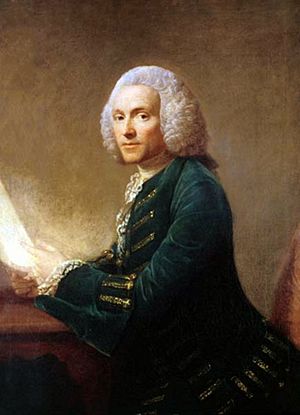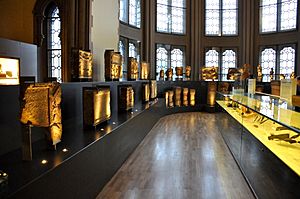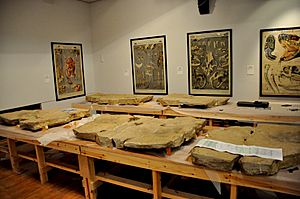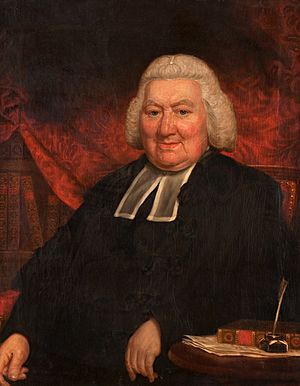Hunterian Museum and Art Gallery facts for kids
The Hunterian is a group of museums run by the University of Glasgow in Glasgow, Scotland. It's the oldest museum in Scotland! This amazing place includes the Hunterian Museum, the Hunterian Art Gallery, the Mackintosh House, the Zoology Museum, and the Anatomy Museum. All these museums are found in different buildings on the university's main campus in Glasgow's west end.
Contents
A Look Back: The Hunterian's History

The Hunterian started thanks to a Scottish doctor named William Hunter. He studied at the University of Glasgow and became a famous anatomist (someone who studies the body's structure). When he passed away in London in 1783, he left all his amazing collections to the University of Glasgow.
William Hunter had a huge collection of items! Besides his medical tools and specimens, he collected coins, minerals, paintings, and even ancient objects from different cultures. He also gathered books, manuscripts, insects, and other animal specimens. His collection forms the heart of the Hunterian. Over time, the museums have added even more incredible things. These include artworks by famous artists like Charles Rennie Mackintosh and James McNeill Whistler. There are also fantastic collections of rocks, animals, ancient artifacts, and scientific tools.
The first Hunterian Museum opened in 1807. It was in a special building near the university's old campus. When the university moved to a new location at Gilmorehill in 1870, the museum moved too. The collections were placed in the university's grand new buildings.
At first, everything was displayed together. But later, some parts of the collection moved to other university buildings. The animal collections are now in the Graham Kerr Building. The art collections are in the Hunterian Art Gallery. William Hunter's library, with over 10,000 books, is in the Glasgow University Library. An ancient Egyptian coffin, possibly with a mummy inside, was given to the museum in 1820.
What You Can See Today
The Main Hunterian Museum
The main Hunterian Museum is located in the beautiful university buildings on Gilmorehill. Here, you can explore many different exhibits. You'll learn about William Hunter and his collections. There are also displays about Roman Scotland, especially the Antonine Wall. You can see exhibits on geology (the study of rocks), ancient Egypt, scientific instruments, and old coins.
The museum also has many donated collections. For example, the Begg Collection of fossils was given in the 1940s. You can also see many scientific instruments that belonged to Lord Kelvin. He was a famous scientist from the 1800s.
In September 2016, a new study center for the Hunterian opened at the Kelvin Hall. This center helps care for and study all the museum's amazing items.
The Zoology Museum
Most of the zoology (animal study) collections are in a separate museum. It's located in the Graham Kerr Building. This museum is also open to everyone. It has very important and large collections of insects. These insect collections have been featured in special exhibitions.
The Hunterian Art Gallery
The Hunterian Art Gallery is a modern building designed especially for art. It's part of the large Glasgow University Library complex. Here, you can see the university's huge art collection. There's even an outdoor sculpture garden! The gallery has many artworks by James McNeill Whistler. It also holds most of the watercolor paintings by Charles Rennie Mackintosh.
The Art Gallery reopened in September 2012 after some updates. It featured an exhibition about the famous artist Rembrandt. Since then, it has hosted several major exhibitions about Mackintosh and Whistler.
The Mackintosh House
The Mackintosh House is a unique part of the gallery complex. It's a modern building that recreates the home of famous Glasgow architect Charles Rennie Mackintosh and his wife, artist Margaret Macdonald Mackintosh. Their original home was at 78 Southpark Avenue. This house was taken down in the 1960s to make space for the university's growth.
The university carefully rebuilt parts of the house about 100 meters from its original spot. The Mackintosh House shows the main rooms of their old home. It includes the dining room, studio-drawing room, and bedroom. You can see original furniture, decorations, and fittings. It really shows how Charles Rennie Mackintosh thought of a room as a complete work of art!
Other Hunterian Museums
William Hunter's brother, John, was also a surgeon and started a museum. The London museum of the Royal College of Surgeons of England is based on his collection. It's also known as the Hunterian Museum. This museum displays thousands of body specimens and surgical tools. It even has the skeleton of a very tall man known as "the Irish giant."
Both brothers were honored in their hometown of East Kilbride at a small place called the Hunter House Museum. However, this museum later closed.
See also
 In Spanish: Hunterian Museum and Art Gallery para niños
In Spanish: Hunterian Museum and Art Gallery para niños
- Glasgow Art







